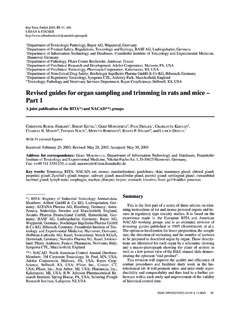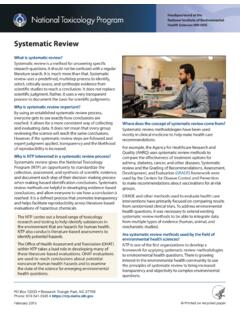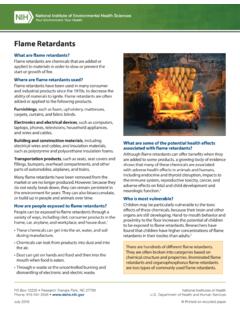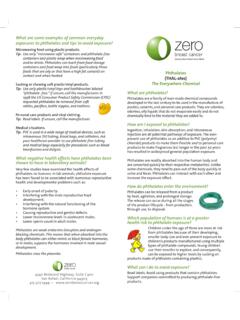Transcription of MANUAL MUSCLE TESTING PROCEDURES For MMT8 TESTING
1 MANUAL MUSCLE TESTING PROCEDURES For MMT8 TESTING June 18, 2007 1 MUSCLE Groups in the MMT8 and Positions to Test: MUSCLE Groups Anti-Gravity Position Gravity-Eliminated Position Deltoid Sitting Supine Biceps Sitting Sitting/Sidelying Wrist extensors Sitting Neutral Quadriceps Sitting Sidelying Ankle dorsiflexors Sitting Sidelying Neck flexors Supine Sidelying Gluteus medius Sidelying Supine Gluteus maximus Prone Sidelying DELTOID Position of Patient: With the patient sitting the elbow should be flexed to indicate the neutral position of rotation. Position of Therapist: The therapist should stand at test side of patient.
2 Place pressure against the dorsal surface of the distal end of the humerus. Test: The patient is to maintain the arm in abduction against gravity. Sample Instructions to Patient: I am going to push down and I want you to resist me. Keep your arm up as I push down. DELTOID: Gravity-Eliminated Position (for weaker patients only) Position of Patient: With patient supine the arm is abducted to 90 but is supported on table with elbow slightly flexed. Position of Therapist: The therapist should stand at TESTING side of patient. Place pressure against the dorsal surface of the distal end of the humerus if the elbow is flexed, or against the forearm if the elbow is extended. 2 Test: Patient attempts to abduct shoulder by sliding arm on table without rotating at the shoulder.
3 Sample Instructions to Patient: Move your arm out to the side. Here, in TESTING shoulder abduction, the patient will be positioned in supine to perform the test in the horizontal plane. The tester will support the arm to minimize the friction between the arm and the TESTING surface, and provide stabilization at the upper trapezius if needed, and instruct the patient to fully abduct the arm. BICEPS Position of Patient: With the patient sitting the elbow is flexed at a right angle, with forearm in supination. Position of Therapist: The therapist should stand in front of and at TESTING side of patient. The hand giving resistance is contoured over the flexor surface of the forearm just proximal to the wrist. The other hand is applied to the humerus to provide a counterforce. Test: Patient flexes elbow against your applied force.
4 If the biceps/brachialis are weak the patient will pronate the forearm before flexing the elbow. Sample Instructions to Patient: Bend your elbow, hold it. Don t let me pull it down. 3 BICEPS: Gravity-Eliminated Position (for weaker patients only) Position of Patient: With patient sitting with 90 shoulder abduction or sidelying the elbow is fully extended. Position of Therapist: The therapist should stand at test side of patient and support abducted arm under the elbow and wrist if necessary. Test: Patient attempts to bend the elbow with the hand supinated. Sample Instructions to Patient: Bend your Seated positioning (left) and sidelying position (right). The sidelying position may be preferred for subjects with limited range at the shoulder. WRIST EXTENSORS Position of Patient: With the patient sitting with the elbow and forearm supported and forearm is in full pronation with the fingers flexed.
5 Position of Therapist: The therapist should stand or sit at a diagonal in front of the patient. Test: Support the patients forearm under the wrist while the other hand used for resistance is placed over the dorsal surface of the metacarpals. Do not permit full extension of the fingers. Sample Instructions to Patient: Bring your wrist up, hold it. Don t let me push it down. 4 WRIST EXTENSORS: Gravity-Eliminated Position (for weaker patients only) Position of Patient: With the patient sitting, the elbow and forearm are supported and the forearm is in neutral position. Position of Therapist: The therapist should stand or sit at a diagonal in front of the patient. Test: Support the patient s wrist. This elevates the hand from the table and removes friction. The patient extends the wrist. Sample Instructions to Patient: Bend your wrist back.
6 QUADRICEPS Position of Patient: With the patient sitting with the trunk approximately perpendicular to the floor, the leg is extended but not locked in extension at the knee. Trunk extension is allowed only if significant hamstring tightness precludes assuming the recommended TESTING position. Position of Therapist: The therapist stands at the side of the tested limb and the TESTING hand is placed over anterior surface of distal leg just above the ankle. The other hand is placed under the distal thigh. Test: The patient extends the knee through available range of motion but do not allow knee to lock into extension during the test. Sample Instructions to Patient: Straighten your knee and hold it, don t let me bend it. Knee extension: standard positioning options using the forearm of the tester (left) or a rolled towel (right) to provide a fulcrum during TESTING .
7 5 QUADRICEPS: Gravity-Eliminated Position (for weaker patients only) Position of Patient: Sidelying with test limb superior to the supporting limb. Lower limb can be flexed for stability. Hold test limb in about 90 of knee flexion with the hip in full extension. Position of Therapist: The therapist stands behind patient at knee level. One arm cradles test limb around thigh with hand supporting underside of knee. The other hand holds leg above the ankle. Test: The patient extends the knee through range of motion and the therapist neither assists nor resists the patient s voluntary movement. Sample Instructions to Patient: Straighten your leg. ANKLE DORSIFLEXORS Position of Patient: With the patient sitting, the knee is flexed at 90 . Position of Therapist: The therapist sits in front of TESTING limb and supports the leg just above the posterior aspect of the ankle joint.
8 Test: The patient dorsiflexes the ankle joint foot without extending the great toe. Pressure is applied on the dorsum of the foot (in the direction of plantar flexion and eversion). Sample Instructions to Patient: Pull your foot up to the ceiling. Ankle dorsiflexion: standard positioning in the frontal plane (left) and the sagittal plane (right). 6 ANKLE DORSIFLEXORS: Gravity-Eliminated Position (for weaker patients only) Position of Patient: Sidelying with test limb superior to the supporting limb. Lower limb can be flexed for stability. Hold test limb in terminal knee extension with the hip in full extension. Position of Therapist: The therapist stands near the subject s feet. The supporting arm supports the test limb just proximal to the malleoli. Test: The patient moves the foot from plantarflexion to dorsiflexion; the therapist neither assists nor resists the patient s voluntary movement.
9 Sample Instructions to Patient: Keep your hip and knee their current position, and move your foot towards your head. NECK FLEXORS Position of Patient: With the patient supine and the arms at their side, the head is supported on a table. Position of Therapist: The therapist stands next to the patient s head and the TESTING hand is placed on the patient s forehead. Test: The patient lifts their head off the table by flexing the neck and tucking the chin. The tester applies resistance at the forehead in the direction of capital and cervical extension and may position a hand underneath the subject s head for protection, or offer additional stabilization across the abdomen (if needed). Sample Instructions to Patient: Lift your head from the table. Do not lift your shoulders and don t let me push down. 7 NECK FLEXORS: Gravity-Eliminated Position (for weaker patients only) Position of Patient: With the patient in sidelying and the head supported on the table while the arms remain at their side.
10 Position of Therapist: The tester will support the head to prevent cervical sidebending, provide stabilization at the anterior shoulder as needed. Test: Instruct the patient to flex their head and neck. Sample Instructions to Patient: Flex your head towards your chest. GLUTEUS MEDIUS Position of Patient: With the patient sidelying, the test leg is superior to the supporting leg. The test limb is slightly extended beyond midline and pelvis is rotated slightly forward. The supporting leg is flexed for stability. Position of Therapist: The therapist stands behind patient and test hand is placed on lateral surface of knee or at the ankle and the other hand is just proximal to greater trochanter of femur. Test: The patient abducts against the applied resistance without flexing or rotating the hip in either direction.









